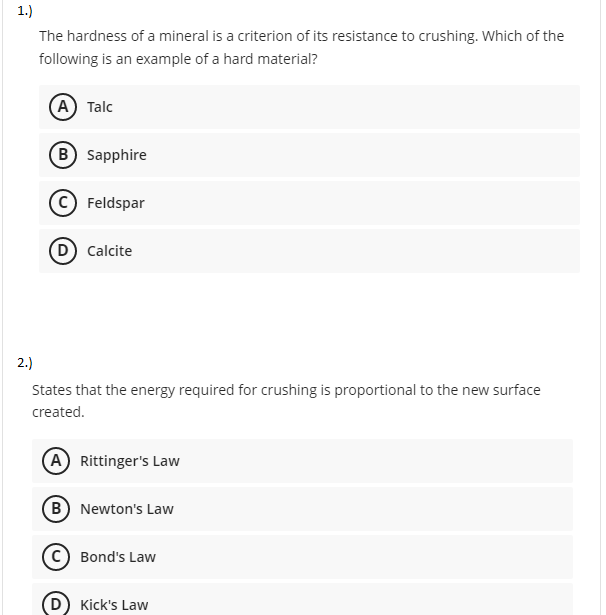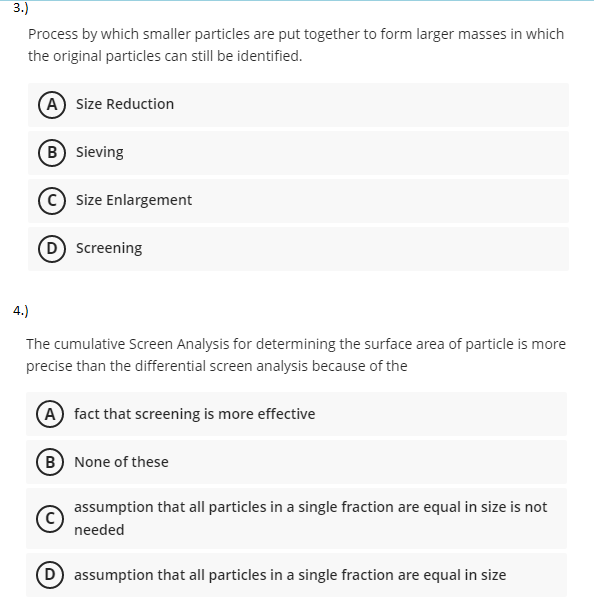The hardness of a mineral is a criterion of its resistance to crushing. Which of the following is an example of a hard material? (А) Talc (B) Sapphire Feldspar (D) Calcite 2.) States that the energy required for crushing is proportional to the new surface created. A Rittinger's Law B Newton's Law Bond's Law
The hardness of a mineral is a criterion of its resistance to crushing. Which of the following is an example of a hard material? (А) Talc (B) Sapphire Feldspar (D) Calcite 2.) States that the energy required for crushing is proportional to the new surface created. A Rittinger's Law B Newton's Law Bond's Law
Introduction to Chemical Engineering Thermodynamics
8th Edition
ISBN:9781259696527
Author:J.M. Smith Termodinamica en ingenieria quimica, Hendrick C Van Ness, Michael Abbott, Mark Swihart
Publisher:J.M. Smith Termodinamica en ingenieria quimica, Hendrick C Van Ness, Michael Abbott, Mark Swihart
Chapter1: Introduction
Section: Chapter Questions
Problem 1.1P
Related questions
Question
this is particle technology need answers asap

Transcribed Image Text:1.)
The hardness of a mineral is a criterion of its resistance to crushing. Which of the
following is an example of a hard material?
A Talc
B Sapphire
(c Feldspar
D) Calcite
2.)
States that the energy required for crushing is proportional to the new surface
created.
A Rittinger's Law
B Newton's Law
Bond's Law
Kick's Law

Transcribed Image Text:3.)
Process by which smaller particles are put together to form larger masses in which
the original particles can still be identified.
A Size Reduction
B Sieving
Size Enlargement
D Screening
4.)
The cumulative Screen Analysis for determining the surface area of particle is more
precise than the differential screen analysis because of the
A fact that screening is more effective
B None of these
assumption that all particles in a single fraction are equal in size is not
needed
D assumption that all particles in a single fraction are equal in size
Expert Solution
This question has been solved!
Explore an expertly crafted, step-by-step solution for a thorough understanding of key concepts.
This is a popular solution!
Trending now
This is a popular solution!
Step by step
Solved in 2 steps with 2 images

Recommended textbooks for you

Introduction to Chemical Engineering Thermodynami…
Chemical Engineering
ISBN:
9781259696527
Author:
J.M. Smith Termodinamica en ingenieria quimica, Hendrick C Van Ness, Michael Abbott, Mark Swihart
Publisher:
McGraw-Hill Education

Elementary Principles of Chemical Processes, Bind…
Chemical Engineering
ISBN:
9781118431221
Author:
Richard M. Felder, Ronald W. Rousseau, Lisa G. Bullard
Publisher:
WILEY

Elements of Chemical Reaction Engineering (5th Ed…
Chemical Engineering
ISBN:
9780133887518
Author:
H. Scott Fogler
Publisher:
Prentice Hall

Introduction to Chemical Engineering Thermodynami…
Chemical Engineering
ISBN:
9781259696527
Author:
J.M. Smith Termodinamica en ingenieria quimica, Hendrick C Van Ness, Michael Abbott, Mark Swihart
Publisher:
McGraw-Hill Education

Elementary Principles of Chemical Processes, Bind…
Chemical Engineering
ISBN:
9781118431221
Author:
Richard M. Felder, Ronald W. Rousseau, Lisa G. Bullard
Publisher:
WILEY

Elements of Chemical Reaction Engineering (5th Ed…
Chemical Engineering
ISBN:
9780133887518
Author:
H. Scott Fogler
Publisher:
Prentice Hall


Industrial Plastics: Theory and Applications
Chemical Engineering
ISBN:
9781285061238
Author:
Lokensgard, Erik
Publisher:
Delmar Cengage Learning

Unit Operations of Chemical Engineering
Chemical Engineering
ISBN:
9780072848236
Author:
Warren McCabe, Julian C. Smith, Peter Harriott
Publisher:
McGraw-Hill Companies, The